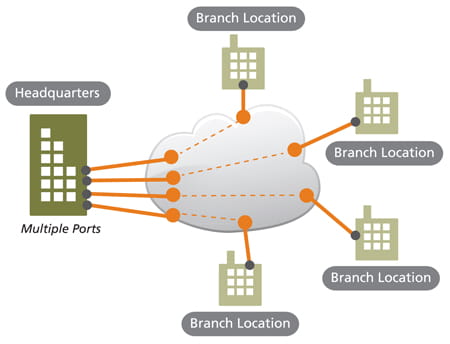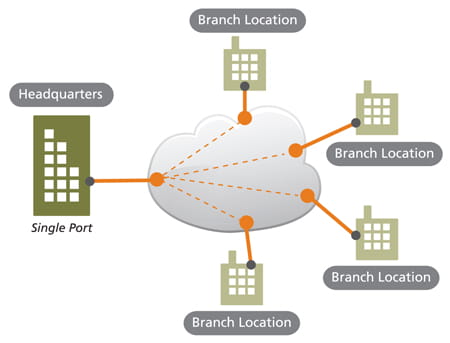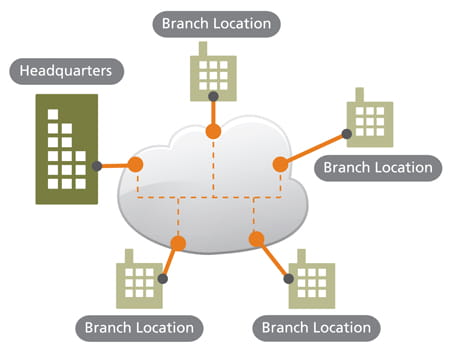The constant need for more bandwidth has driven the surge in Ethernet solutions. Where it once took days or weeks to increase bandwidth using other Wide Area Network (WAN) technologies, Ethernet usually requires only hours.
Ethernet is one of the most significant innovations of this generation—and has now evolved from Local Area Networks (LANs) to the Metro Area Network (MAN). The implications of these capabilities are immense.
- Scalability, Ubiquity, and Reach: With many businesses seeing capacity growth rates of 20 to 30 percent per annum, Ethernet scalability is vital to meeting this capacity demand. Ethernet is already available in a wide range of interface speeds from 5 Megabits per second (Mbps) to 10 Gigabits per second (Gbps). The next dimension to scalability is geographical reach. Carrier Ethernet spans metro, national, and global networks. Work is ongoing at the Metro Ethernet Forum (MEF) to standardize the interconnection of Ethernet networks operated by different service providers to further increase the reach of such services and offer customers a consistent end-to-end service.
- Performance, QoS and Suitability for Convergence: Inherently, Ethernet networks utilize packet switching technologies (MPLS, IP) that require less processing to operate and manage multiple IP technologies at higher bandwidth(s) than legacy platforms. Low Latency and Delay variations over fiber medium make Ethernet the best solution for voice, video, and data.
- Cost Savings: The Carrier Ethernet and MPLS technologies used for service delivery reduce cost by eliminating many network add, move, and change procedures by simplifying network operations as compared to legacy WAN support protocols. With network elements and simpler network operations, there are plenty of opportunities to save through network consolidation.
- Control, Simplicity, Familiarity: IT departments manage Ethernet connectivity every day and now have more control with simpler network provisioning and configuration management, with lower cost.
- Expediting and Enabling New Applications: Ethernet accelerates implementation of data applications for data file transfer, internet access, off-site data storage, access to hosted servers, outsourced mail, file servers, and application servers with reduced resources for overburdened IT departments.
- Consistency, Predictability and Risk Reduction: The Class of Service (CoS) mechanisms and Layer 2 control processing methods provide guaranteed performance of such parameters as delay variation, information rates, and information loss recovery mechanisms.
- Reliability and Protection: The Ethernet E-LAN and E-Line Operation, Administration, and Maintenance (OAM) tools on the Ethernet platforms create the highest degree of network reliability. Secure, easily managed connectivity with Virtual routing and forwarding (VRF) creates a secure Layer 3 VPN. Unlike ATM and Frame Relay solutions, virtual circuits do not need to be defined for connectivity to each networked location.
- Flexibility, Adaptability: When network architectures are continuously evolving and new service delivery models are constantly emerging, customers require unprecedented flexibility in network platforms to adjust to their changing future.
GVTC Ethernet Products Available
Provides point-to-point connectivity between two business locations with scalable bandwidth speeds via an Ethernet Virtual Circuit (EVC). Ethernet Virtual Circuit (EVC) is created within a User Network Interface (UNI) to UNI connection to provide Ethernet connectivity between two locations.
Network Design:
Fiber: Ethernet hand-off to each customer location via an Optical Network Terminal (ONT) on Gigabit-capable Passive Optical Networks (GPON) Fiber network inter-connected via MPLS core IP network.

EPL Service Options:
- Bandwidth from 5 Mbps to 1 Gbps with Committed Information Rates (CIR)
EPL Feature Characteristics
- Replaces a TDM (Legacy) Private Line.
- Port-based service with single service (EVC) across dedicated UNIs providing site-to-site connectivity
- Typically delivered over SDH (Synchronous Digital Hierarchy) Ethernet over SDH
- Most popular Ethernet service due to it's simplicity
- Effective means of connectivity for other value-added services, including internet access, LAN extension, data backup, video applications, and other critical applications.
point-to-multipoint configuration or Ethernet Virtual Private Line (EVPL). EVPL is built in a "hub-and-spoke" design with the headquarters (hub) location at the center. The "spoke" locations are connected so they can securely communicate back to the hub. An Ethernet Virtual Private Line (EVPL) is created using an E-Line Service type. An EVPL can be used to create services similar to the Ethernet Private Line (EPL) with some notable exceptions. First, an EVPL allows for service multiplexing at the UNI. This capability allows more than one Ethernet Virtual Circuit (EVC) to be supported at the UNI where the EPL does not allow this. Second, an EVPL need not provide as much transparency of Service Frames as with an EPL. Because service multiplexing is permitted, some Service Frames may be sent to one EVC while other Service Frames may be sent to other EVCs.
Network Design:
Fiber: Ethernet hand-off to each customer location via an Optical Network Terminal (ONT) on Gigabit-capable Passive Optical Networks (GPON) fiber network inter-connected via MPLS core IP network. EVCs are service multiplexed to one UNI at "hub" location.

EVPL Service Options:
- Bandwidth from 5 Mb to 1 Gb with Committed Information Rates (CIR)
EVPL Feature Characterisitcs
- Replaces Frame Relay or ATM L2 VPN services
- Enables Multi-EVCs to be delivered over single physical connection (UNI) to customer premises
- Supports 'hub and spoke" connectivity via service multiplexed UNI at hub site
- Efficient use of router ports
This service enables any-to-any communication between all customer locations associated with the multipoint-to-multipoint Ethernet connection. (ELAN) is an excellent choice for enterprises who need any-to-any communication between not only the headquarter location and its branch offices, but between the individual branch offices as well. ELAN is a cost-effective alternative to legacy technologies because it enables companies to lower their total cost of ownership by reducing capital outlays on routers, switches, and hardware.
Network Design:
Fiber: Ethernet hand-off to each customer location via an Optical Network Terminal (ONT) on Gigabit-capable Passive Optical Networks (GPON) fiber network inter-connected via MPLS core IP network. EVCs are allowed multi-point to multi-point communication utilizing MPLS features. The E-LAN service is defined to provide E-VLAN tag preservation and tunneling of key Layer 2 Control Protocols. A key advantage of this approach is that the Subscriber can configure VLANs across the sites without any need to coordinate with the Service Provider. Each interface is configured for All to One Bundling and, therefore, E-LAN service supports E-VLAN ID preservation. In addition, E-LAN supports E-VLAN CoS preservation.

ELAN Service Options:
- Bandwidth from 5 Mb to 1 Gb with Committed Information Rates (CIR)
ELAN Feature Characterisitcs
- Replaces Frame Relay or ATM L2 VPN services
- Enables Multi-EVCs to be delivered over single physical connection (UNI) between customer premises
- Supports "multi-point to multi-point" connectivity
- Efficient use of router ports

